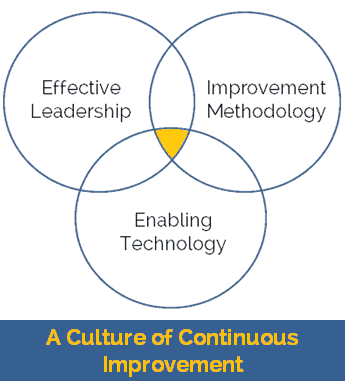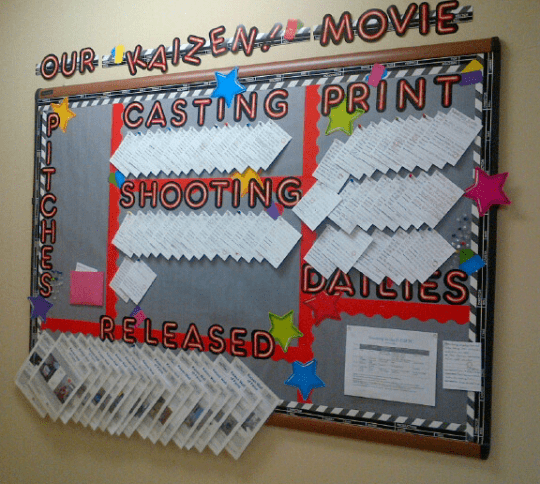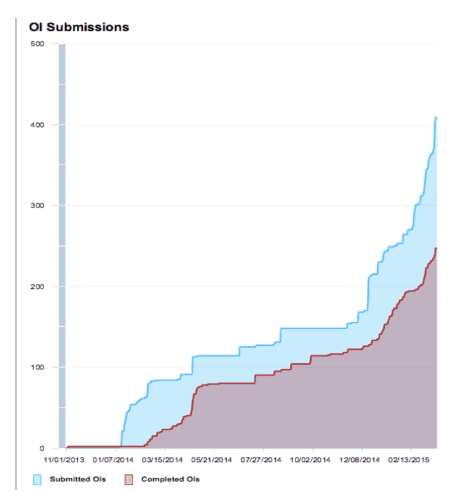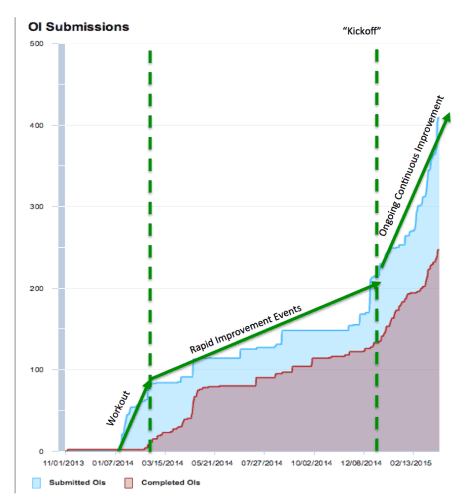 I recently wrote a blog post for KaiNexus titled “How Kaizen Software Helps Me Be A Better Coach.” I've done a lot of Kaizen coaching with organizations and one challenge is me keeping up with their progress as a remote coach. Without the KaiNexus software, people have to manually tally up the number of improvements or they share photos of their Kaizen boards.
I recently wrote a blog post for KaiNexus titled “How Kaizen Software Helps Me Be A Better Coach.” I've done a lot of Kaizen coaching with organizations and one challenge is me keeping up with their progress as a remote coach. Without the KaiNexus software, people have to manually tally up the number of improvements or they share photos of their Kaizen boards.
Two key questions are “how many ideas have been generated?” and “what percentage have been implemented?”
Late last year, I worked with a KaiNexus customer to conduct a “Kaizen Kickoff,” a three-day workshop where I teach a bit about Kaizen and then, more important, actively coach leaders and staff on the Kaizen process. We're identifying, mainly, small problems and opportunities for improvement that can be solved within the local team in a Plan-Do-Study-Adjust manner. And, I'm teaching them to do so on an ongoing basis, to make that a new habit.
 I'm using a football analogy with the term “Kickoff,” but this could also be viewed as a “Kaizen Boot Camp” (like the military or the exercise approach) or, since baseball season is starting, it's like a “Kaizen Spring Training” to build capabilities and practice.
I'm using a football analogy with the term “Kickoff,” but this could also be viewed as a “Kaizen Boot Camp” (like the military or the exercise approach) or, since baseball season is starting, it's like a “Kaizen Spring Training” to build capabilities and practice.
As we say at KaiNexus (and I believe this strongly, of course), you need three things for a culture of continuous improvement to take shape and to sustain:
- Methodology (in this case, it's Kaizen)
- Leadership (the right behaviors that encourage and support Kaizen)
- Enabling technology

My Kaizen Kickoff sessions have been effective because I'm teaching (and coaching) them an improvement methodology and I'm also coaching them on “effective leadership.” This leadership approach includes asking for improvements on a regular basis, encouraging people to point out problems, and working together with employees to find SOMETHING that can be implemented. Basically, the types of practices that Greg Jacobson, MD and I talk about in these videos.
The Kaizen Kickoff process has worked in environments where the team has a visual Kaizen board (and sometimes they get really creative with the board after I leave):

But, it's been great when that KaiNexus customer has used our software platform to identify, track, and implement their ideas, tallying their results as they go. I get visibility to that progress and data via our web app.
Let's look at a hospital's chart of the number of “opportunities for improvement” that were submitted (blue) and completed (red).
Here's the chart over time:

That looks like pretty steady progress over time. The gap between the blue and red shows the identified problems or opportunities that have not yet been completed (their “Work In Process” or WIP). It's important to not let that gap get too wide… we have to not just identify opportunities, we need to take action to investigate and work toward solutions.
About 85% of their completed ideas have led to some sort of positive change being implemented (which is FAR better performance than a suggestion box system traditionally would get).
Below is the chart that I've now annotated:
The first part of the curve was a period in which a “WorkOut” process was utilized to engage leaders from different departments to each generate at least one idea to implement in each area. About 80 ideas were identified across the hospital, but you can see there was about a three month lag before the red line caught up to the blue… when the ideas were being implemented. Since that WorkOut is a three-month initiative, that's probably not surprising that ideas or projects took that long.
Unfortunately, the WorkOut didn't lead to much ongoing continuous improvement, as we might have hoped. I've found this usually happens not because people have run out of ideas, but because leaders aren't engaging people and asking them to improvement.
In the next period (in between the dashed green lines), the hospital focused mainly on Rapid Improvement Events, which is why the blue line goes up like a number of step functions. Each Event generated numerous opportunities for improvement, but the improvement was more episodic and sporadic than continuous. Those events are great and, like the WorkOut had some impressive results, but we all wondered how can a hospital have improvement taking place every day?
That's where I came in to lead the “Kaizen Kickoff” in mid December, working closely with an internal process improvement coordinator who would then keep mentoring and coaching internally, working to spread the Kaizen methodology across more departments (I only worked with two departments in those three days).
Staff members and leaders (mostly staff) generated about 30 ideas in the three days of the Kickoff and they started working on them while I was there. Teaching them a methodology and coaching them on leadership was more effective than just saying “everybody go improve.” As Dr. W. Edwards Deming would ask, “By what method?” Kaizen was that method.
See how the slope of that green line increased? The hospital is still running Rapid Improvement Events, but they are also still practicing daily continuous improvement, which means more improvement and better results.
Through the KaiNexus system, I get email notifications every day that show the new opportunities for improvement and what's been implemented (and what the results are). I enjoy how the KaiNexus technology keeps me plugged in to keep coaching and mentoring via phone and email. It helps all of us do a better job of collaborating, as coach and as client.
I love seeing the boost that this Kaizen Kickoff process gave them… and I love how they have been running with it and continue to do so. More people, more departments, more participation, more improvement. A coach can't make that happen… a coach can only help when the leadership and the energy already exists at the hospital, starting with the CEO.
Let me know if I can help you with one of these Kickoffs.
New 3-for-2 Kaizen Workshop Pricing
See an amazing “Kaizen culture” first hand at Franciscan St. Francis Health in Indianapolis, April 22-23. New… bring three people for the price of two. … click the image below to learn more or register.
What do you think? Please scroll down (or click) to post a comment. Or please share the post with your thoughts on LinkedIn – and follow me or connect with me there.
Did you like this post? Make sure you don't miss a post or podcast — Subscribe to get notified about posts via email daily or weekly.
Check out my latest book, The Mistakes That Make Us: Cultivating a Culture of Learning and Innovation:











I recently talked with the PI leader from this hospital and after I helped them with the first two units, they have now spread the Kaizen methodology and KaiNexus software into 14 department, soon to be 18.
Because I helped “train the trainer” and continue to mentor him, he’s adding roughly one new department every week. He’s also now developing a second Kaizen coach who will be able to work independently to speed up their spread of KaiNexus.
They expect to have done their initial spread of Kaizen by July. Then, they are going to make a second pass to come back and coach people on developing better problem solving skills.